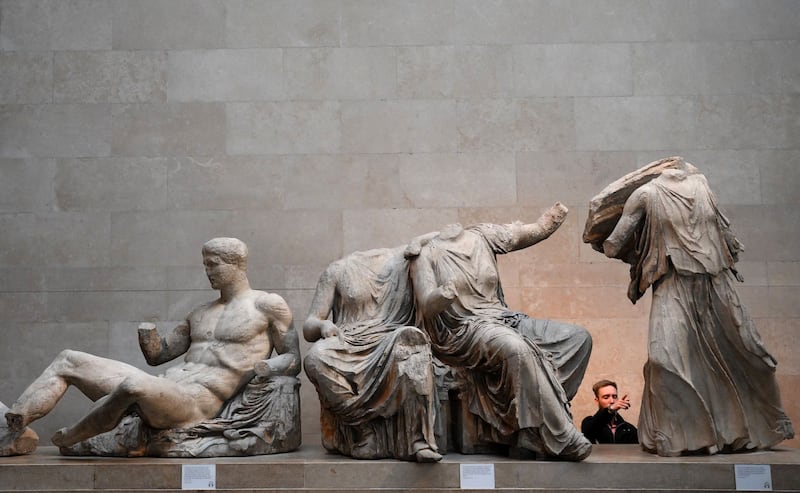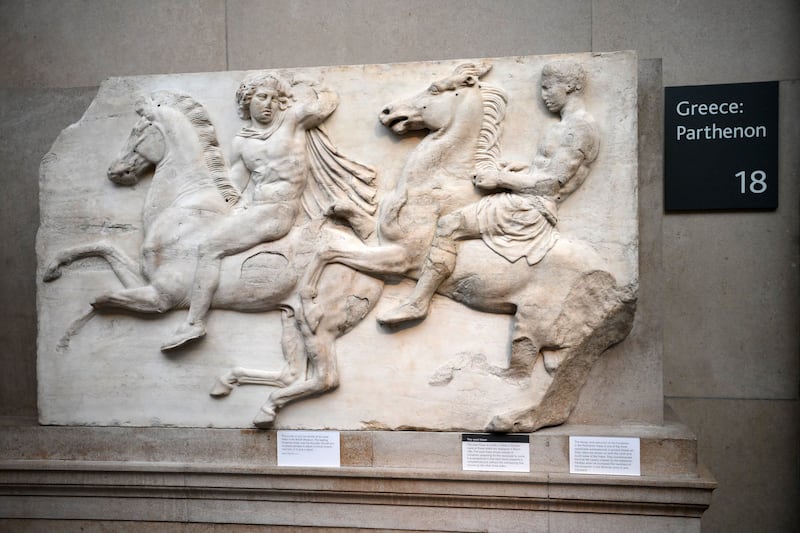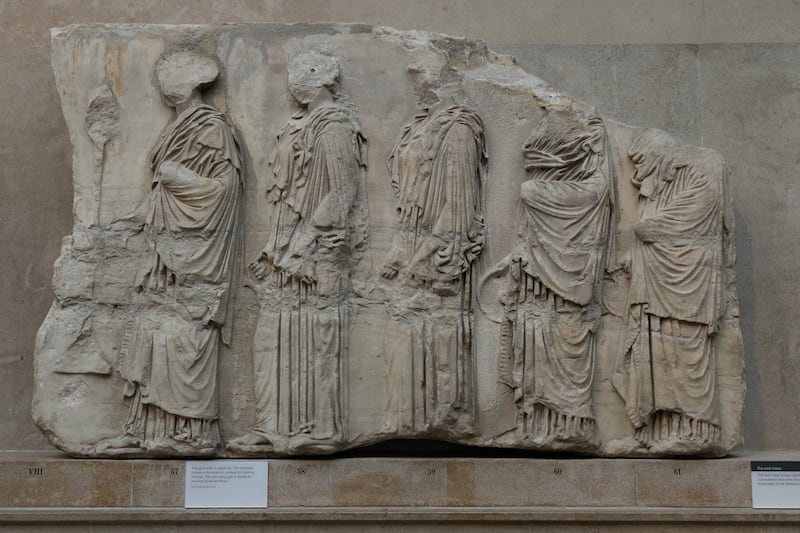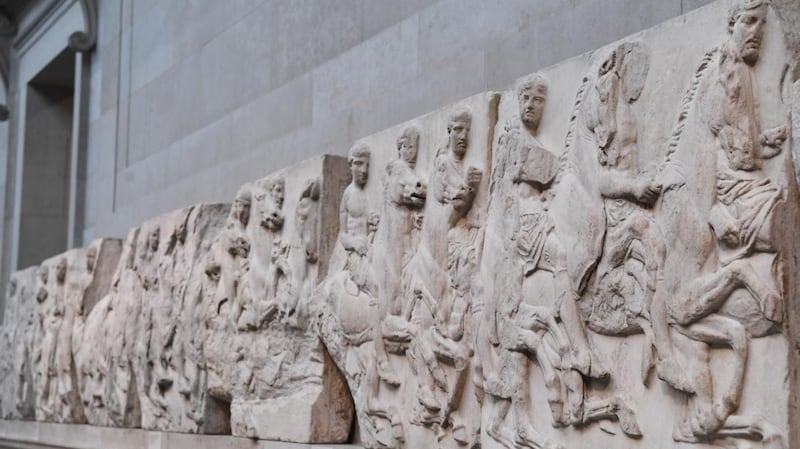When Lord Elgin, a British aristocrat, sailed home from Greece in the early 1800s, he also shipped to England some of the greatest treasures of antiquity: a collection that included statues of Greek gods and carved frieze panels depicting battling centaurs that once decorated the Parthenon in Athens.
Torn in some cases from the temple walls, ostensibly with the permission of the Ottomans who then ruled Greece, the so-called Elgin Marbles were later sold to the British government and became some of the most storied artefacts in the collection of the British Museum.
But they also became, almost from the very day they were removed, the subject of perhaps the world’s most notorious cultural dispute.
Since the days of Lord Byron, the romantic poet who was an early critic of their removal, the fate of the marbles has been bitterly contested. The British say the marbles were legally acquired and are best shown alongside other artefacts in a universal museum, while the Greeks view them as looted treasures that are a foundation of their national heritage.
READ MORE

The debate has only deepened in recent years as the actions of old empires have come under new scrutiny, and restitution battles have come to challenge the foundations of Western museums. The pressure to return the marbles has grown as museums have given back high-profile items including Benin Bronzes, Italian antiquities and other fragments from the Parthenon that were relinquished just last month by the Vatican.
Now there are hopeful signals that perhaps a resolution between the British Museum and Greece could be in sight as officials on both sides have acknowledged that secret talks have taken place. But even as those disclosures have flowered into optimism that real progress will soon be made, both sides have made it clear that no deal is yet imminent.
Indeed, they remain far apart on some key questions.
The talks have been ongoing in London since November 2021, between prime minister Kyriakos Mitsotakis of Greece and George Osborne, a former finance minister of Britain who is now the chair of the British Museum. In the seclusion of plush hotels and at the Greek ambassador’s town house, the parties have been trying to reach a deal on the marbles’ future, say two people with knowledge of the negotiations who were granted anonymity to discuss confidential talks. One of those people had knowledge of the Greek position; the other knew the British Museum’s.
At several of those meetings, Giorgos Gerapetritis, a minister without portfolio in Greece’s government, acted as Mitsotakis’ representative, say both people.

Just how well the negotiations have gone has been a matter of much speculation. One article last month in the Greek newspaper Ta Nea, which broke news of the talks, said they were “90 per cent” complete, citing “well-placed” Greek sources. Bloomberg reported last week that the parties were “closing in” on a deal, and other optimistic accounts have followed elsewhere. Under the discussed proposal, the Bloomberg article said, some of the monuments would return to Athens temporarily, in exchange for other ancient treasures.
[ Elgin Marbles highlight Ireland’s complicated role in British empireOpens in new window ]
But a deal remains much further away than those reports suggest, say the two people with knowledge of the negotiations who spoke to the New York Times. And, in fact, in recent days officials from both sides have spoken publicly to pump the brakes on the soaring expectations that any deal was imminent.
For his part, Mitsotakis has asked the British Museum to return all of the frieze in its collection, some 250 feet of carved stone that once wrapped around the Parthenon, the person with knowledge of the Greek position said. Mitsotakis wanted an agreement that those panels would stay in Greece for at least 20 years. There, they would be reunited with other parts of the frieze already on display in the Acropolis Museum in Athens.
That person said Mitsotakis hoped that, after 20 years, the agreement would be extended so the frieze panels would remain in Athens.

The Greek side hoped to negotiate the return of the remaining sculptures at a later date, the person with knowledge of its position said. In return for the frieze, Greek museums would supply the British Museum with a rotating selection of priceless artefacts, some of which had never left Greece, the person said.
The British Museum wants a different deal, say the person with knowledge of its position. So far, Osborne has suggested returning a smaller portion of the frieze, as well as carvings of gods and centaurs, as a short-term loan, the person said. The museum could offer up to one-third of the Parthenon artefacts in its collection, the person said.
Once Greece returned those artefacts to London, more would be sent to Athens to replace them, the person said. Over time, the number of artefacts sent to Greece would increase, to reflect growing trust between the two sides, the person said.
The British Museum’s view is that it cannot offer more, even if it wanted to, the person with knowledge of its position said. Under British law, the museum cannot remove items from its collection unless they are “unfit to be retained,” though it is free to loan objects to other institutions. The museum argues that Lord Elgin acquired the artefacts legally, after administrators of the Ottoman Empire, which governed Athens at the time, gave him a permit. It also insists that the sculptures are best presented among the museum’s global collections so that they tell part of a broader story about human civilisation.
If any agreement with the Greek government did not include a provision that the marbles must return to London, it could be challenged in Britain’s courts. But any deal would be written in a way that did not require Greece to give up its claim for ownership of the artefacts, the person with knowledge of the museum’s position said.

The British Museum declined to comment on the negotiations, but a museum spokesman acknowledged by email that they were taking place. “We’re actively seeking a new Parthenon partnership with our friends in Greece, and, as we enter a new year, constructive discussions are ongoing,” the spokesman said.
Other large Western collections, including the Smithsonian Institution and the Humboldt Forum, in Berlin, have recently returned high-profile disputed artworks, and the British Museum looks increasingly out of step. As well as the Parthenon artefacts, it holds an extensive collection of Benin Bronzes, claimed by Nigeria; the Rosetta Stone, which some archaeologists want returned to Egypt; and a statue from Easter Island that the Rapa Nui, the island’s Indigenous people, have asked for.
Legal experts and museum administrators worldwide are watching the situation closely.
“If there was some kind of deal, it would be a great symbol for others seeking restitution claims,” said Alexander Herman, the director of the Institute of Art and Law, in London.
Max Hollein, the director of the Metropolitan Museum of Art in New York, said “the whole question of the Elgin Marbles is such a long and complex story” that any solution “would be a large step for the institutions, and for the cultural dialogue in the world”.
The Met recently reached a deal with Greece so that the New York museum could display a collection of Cycladic antiquities assembled by philanthropist Leonard N Stern while acknowledging that, ultimately, the artefacts belong to the Greek state. Under the deal, artefacts will travel between the United States and Greece. Hollein said Greece’s government was open to negotiating innovative solutions to restore ownership of the country’s cultural heritage while allowing items to be displayed abroad.
At the British Museum recently, the gallery where the marbles are displayed was filled with tourists, many snapping selfies in front of the statues and the frieze.
Dilan Polat (20) an art student who was sketching a centaur’s muscled torso from one of the panels, said she felt “really lucky to be able to draw actual Greek sculptures.” But, she said, they should return “to their rightful place” in Greece. John Lancaster (59), a bus driver, said the marbles should return to Greece since they were part of that country’s history. “It’s like the Crown Jewels,” Lancaster said. “If someone took those, you’d want them back, wouldn’t you?” – This article originally appeared in The New York Times.














